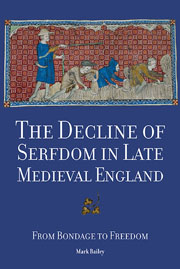Book contents
- Frontmatter
- Contents
- List of Maps
- List of Graphs
- List of Tables
- Acknowledgements
- Abbreviations
- Part I The Decline of Serfdom: Questions and Approaches
- Part II Case Studies
- Part III Conclusions
- 13 The Chronology of the Decline of Serfdom
- 14 From Bondage to Freedom: Towards a Reassessment
- Appendix: List of original sources used in this study
- Chronology
- Bibliography
- Index
13 - The Chronology of the Decline of Serfdom
from Part III - Conclusions
Published online by Cambridge University Press: 05 March 2014
- Frontmatter
- Contents
- List of Maps
- List of Graphs
- List of Tables
- Acknowledgements
- Abbreviations
- Part I The Decline of Serfdom: Questions and Approaches
- Part II Case Studies
- Part III Conclusions
- 13 The Chronology of the Decline of Serfdom
- 14 From Bondage to Freedom: Towards a Reassessment
- Appendix: List of original sources used in this study
- Chronology
- Bibliography
- Index
Summary
Issues, methods and sources
Chapter 1 sketched how historians have come to regard serfdom as central to an understanding of the economy and society of late medieval England. Its decline is also regarded as central to an understanding of how and why England became the world's first industrial society, because this was an essential prerequisite for the development of a free market in wage labour and the creation of capitalist farming. Yet, despite the subject's importance, the issue of exactly when serfdom disappeared during the fourteenth and fifteenth centuries, and why, has not been re-assessed for decades.
There were two basic elements of villeinage in England, namely unfree tenure and personal (hereditary) unfreedom. Villein tenure is assumed to have shed its main servile incidents – tallage, week works, millsuit and heriot – between c.1370 and c.1410, and then evolved through a variety of rather indistinct tenurial forms before emerging during the sixteenth century as copyhold tenure (Chapter 2). Hereditary personal servility – characterized by liability to leyrwite, merchet and chevage – lingered a little longer, but by the middle of the fifteenth century it had dwindled to the point of irrelevance, after which the numbers of serf families in England could be counted in their hundreds rather than tens of thousands (Chapter 3). Serfdom just withered away during the fifteenth century and its last vestiges were finally eradicated during the sixteenth century.
- Type
- Chapter
- Information
- The Decline of Serfdom in Late Medieval EnglandFrom Bondage to Freedom, pp. 285 - 306Publisher: Boydell & BrewerPrint publication year: 2014

